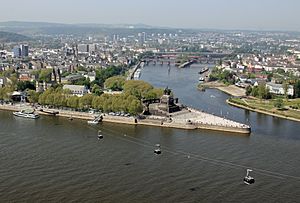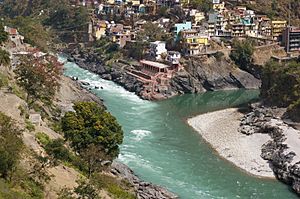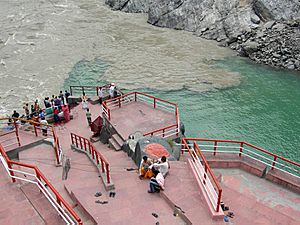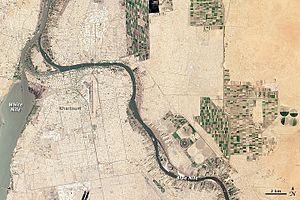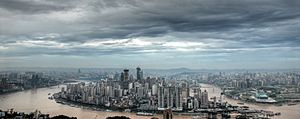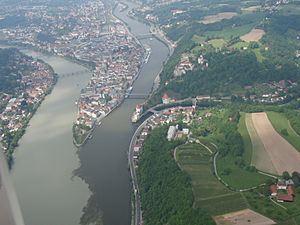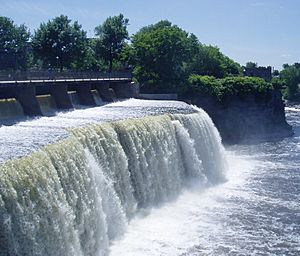Confluence facts for kids
In geography, a confluence is where two or more rivers or streams meet and join together to form one single channel. Think of it like different paths coming together to form one bigger path. This can happen in a few ways:
- A smaller river, called a tributary, joins a larger river.
- Two streams meet to become the very start of a new river with a new name. For example, the Monongahela and Allegheny rivers meet in Pittsburgh to form the Ohio.
- A river might split into two channels around an river island and then rejoin further downstream.
Contents
Why do rivers have different colors when they meet?
When rivers meet, you can often see differences in their water colors. This happens because each river's color is affected by many things. These include the types of plants growing in the area, the rocks and soil, chemicals dissolved in the water, and even tiny bits of sediment or algae. These color differences can sometimes be seen for many miles downstream before the waters finally mix completely.
How confluences are important to people
Confluences have always been important places for people.
Confluences and borders
Since rivers often act as natural borders, confluences can sometimes mark the meeting point of three different political areas, like countries, states, or provinces. This special spot is called a tripoint. You'll see many examples of these in the list below.
Cities and monuments at confluences
Many big cities, like Lyon in France, Khartoum in Sudan, and St. Louis in the USA, grew up at confluences. These spots were great for trade and travel. Within a city, a confluence is often a beautiful and important place. Because of this, people sometimes build famous public buildings or monuments there. Good examples are the Deutsches Eck in Koblenz, Germany, the Musée des Confluences in Lyon, and The Forks in Winnipeg, Canada.
Cities also often create parks at confluences to make the area nicer. Kelley Point Park in Portland, USA, and Point State Park in Pittsburgh, USA, are great examples. Sometimes, a confluence is used for industrial purposes, like the Philadelphia Naval Shipyard in Philadelphia. Other times, the area around a confluence is a floodplain (flat land that floods easily), so nothing is built there, like near Manaus in Brazil.
Famous Confluences Around the World
Africa
- At Lokoja, Nigeria, the Benue River flows into the Niger.
- At Kazungula in Zambia, the Chobe River flows into the Zambezi. This meeting point helps define where the borders of Zambia, Botswana, and Namibia meet. Just a little further downstream, the borders of Zambia, Botswana, and Zimbabwe also meet.
- The capital city of Sudan, Khartoum, is located where the White Nile and the Blue Nile meet. This is where the famous Nile River officially begins!
Asia
- About 82 kilometers north of Basra in Iraq, at the town of Al-Qurnah, the Tigris and Euphrates rivers join to form the Shatt al-Arab.
- The River Swat joins the River Kabul near Attock, in Pakistan.
- At Devprayag in India, the Ganges River starts where the Bhagirathi and the Alaknanda rivers meet. You can see pictures of this above.
- The Sangam, near Allahabad, India, is where the Yamuna River flows into the Ganges.
- Kuala Lumpur, the capital of Malaysia, is located where the Gombak River (which used to be called "muddy river") flows into the Klang River.
- The Nam Khan River flows into the Mekong at Luang Prabang in Laos.
- The Jialing flows into the Yangtze at Chongqing in China. This confluence is a main feature of the city, with a large square called Chaotianmen Square built there in 1998. From the square, visitors can see many ships, bridges, tall buildings, and people.
- In the Far East, the Amur forms the border between China and Russia. The Ussuri River, which also marks the border, flows into the Amur. This meeting point is in a rural area of China, where a park called Dongji Square has been built. It has a huge sculpture of the Chinese character for "East." This border region had a dispute in 1969, but the border near the confluence was peacefully settled by a treaty in 2008.
Australia
- Australia's two largest rivers, the Murray and its tributary the Darling, meet at Wentworth, New South Wales. (See Gallery below for an image.)
- The Franklin flows into the Gordon in south-western Tasmania.
Europe
Seine River confluences
- The Seine River splits in the historical center of Paris, flowing around two islands, the Île Saint-Louis and the Île de la Cité. Where the river becomes a single channel again, the Île de la Cité is crossed by the famous Pont Neuf bridge. This spot has been painted many times by famous artists like Monet and Renoir.
- Further upstream, the Marne River flows into the Seine at Charenton-le-Pont, just outside Paris. A large Chinese-managed hotel, the Huatian Chinagora, is located there. (See Gallery for an image.)
Rhine River confluences
- The Main River flows into the Rhine River just south of Mainz, in Germany. (See Gallery below for an image.)
- The Mosel River flows into the Rhine further north at Koblenz. The name "Koblenz" actually comes from a Latin word meaning "confluences." In German, this meeting point is called the "Deutsches Eck" ("German corner") and has a huge monument celebrating German unification.
- Upstream in Switzerland, a small town also named Koblenz (for the same reason) is where the Aare River joins the Rhine.
Danube River basin confluences
- Passau in Germany is sometimes called the "City of Three Rivers" (Dreiflüssestadt). This is because the Danube River is joined there by the Inn River from the south and the Ilz River from the north.
- The Thaya flows into the Morava River in a rural area near Hohenau an der March in Austria. This spot forms the tripoint where Austria, Czechia, and Slovakia meet.
- The Morava River flows into the Danube River at Devín, on the border between Slovakia and Austria. (See Gallery below for an image.)
- The Sava River flows into the Danube River at Belgrade, the capital of Serbia.
- The meeting point of the Pivka and Rak rivers is one of the largest underground confluences in Europe.
Other European confluences
- Lyon, France is located where the Saône River flows into the Rhone River. A big new science and anthropology museum, the Musée des Confluences, opened at this site in 2014.
- The Lusatian Neisse River flows into the Oder River in Poland, across from a German village called Ratzdorf. These two rivers form the Oder-Neisse line, which is the border between Germany and Poland after World War II.
- The Triangle of Three Emperors was a former political tripoint in present-day Poland. Before World War I, the borders of the Austrian, German, and Russian empires met there.
- Rovaniemi, the capital of Finnish Lapland, is one of the largest towns above the Arctic Circle. It is at the confluence of the Ounasjoki and Kemijoki rivers.
- Kryvyi Rih, Ukraine is named after and located at the meeting point of the Saksahan and Inhulets River.
- The Oka River flows into the Volga River at Nizhny Novgorod in Russia. The Alexander Nevsky Cathedral overlooks this site. (See Gallery below for an image.)
North America
Mississippi River basin confluences
- Vicksburg, Mississippi sits on high ground overlooking where the Mississippi River meets its tributary, the Yazoo. Both rivers and the bluffs were very important during the Vicksburg Campaign in the American Civil War.
- The Missouri River flows into the Mississippi River at Jones-Confluence Point State Park, just north of St. Louis, Missouri. A little further upstream, the Illinois River also flows into the Mississippi.
- The Madison, Jefferson, and Gallatin rivers meet in Three Forks, Montana to form the start of the Missouri River.
- At Keokuk, Iowa, the Des Moines River flows into the Mississippi. This creates a political tripoint for the U.S. states of Iowa, Missouri, and Illinois.
- Just south of Cairo, Illinois, the Ohio River flows into the Mississippi. This forms another tripoint for the states of Illinois, Missouri, and Kentucky.
- The Ohio River itself is formed by the meeting of the Monongahela and Allegheny rivers in Pittsburgh, Pennsylvania. This place is very important historically. In the 1970s, it was improved with the creation of Point State Park, which has a large fountain.
Atlantic Ocean watershed confluences
- At Harpers Ferry, West Virginia, the Shenandoah River flows into the Potomac River. This is a tripoint for the U.S. states of Virginia, West Virginia, and Maryland.
- At Philadelphia, Pennsylvania, the Schuylkill River flows into the Delaware River. This area used to be a naval shipyard and is still industrial.
- At Cohoes, New York, a few miles north of Albany, the Mohawk River flows into the Hudson through three channels. This confluence was historically important because it offered a unique, flat path through the Appalachian Mountains, which helped trade and settlement in the west.
- At Ottawa, the capital of Canada, the Rideau River flows into the Ottawa River as a waterfall! This is called Rideau Falls. There's a park with military monuments on the island between the two parts of the falls.
- The Hochelaga Archipelago, which includes the island and city of Montreal, is located where the Ottawa River flows into the St. Lawrence River in Quebec, Canada.
- Winnipeg, Canada, is at the meeting point of the Red River and the Assiniboine River. Locals call this area The Forks, and it has been an important trading spot for over 6,000 years.
Pacific Ocean watershed confluences
- The Green River flows into the Colorado River in the middle of Canyonlands National Park in Utah. (See Gallery below for an image.)
- The Snake River flows into the Columbia River at the Tri-Cities area of Washington.
- In Portland, Oregon, the Willamette River flows into the Columbia River at Kelley Point Park. This park was created on land bought in 1984. (See Gallery below for an image.)
- Lytton, British Columbia, Canada, is located where the muddy Fraser River meets the clearer Thompson River. (See Gallery below for an image.)
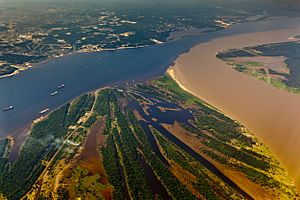
South America
- Manaus, Brazil is on the Rio Negro near where it meets the Amazon. This meeting is famously known as the Meeting of Waters. Manaus is a major port and a central point for the region's large river system.
- The Iguazú flows into the Paraná at the "Triple Frontier" (La Triple Frontera in Spanish, Tríplice Fronteira in Portuguese). This is the tripoint for Paraguay, Argentina, and Brazil.
Other types of confluences
Sometimes, the word "confluence" is used to describe where other bodies of water meet, not just rivers. This could be two canals, or a canal and a lake. For example, a part of the Industrial Canal in New Orleans is also used by the Gulf Intracoastal Waterway and the Mississippi River-Gulf Outlet Canal. So, these three waterways meet there.
The term confluence can also describe when two glaciers merge together. (See Gallery below for some images.)
Images for kids
-
The fountain at Point State Park in Pittsburgh, at the very tip of where the Allegheny (top) and the Monongahela rivers meet.
-
Canal confluence This diagram shows how a section of the Industrial Canal in New Orleans is also used by the Gulf Intracoastal Waterway and the Mississippi River-Gulf Outlet Canal.
See also
 In Spanish: Confluencia para niños
In Spanish: Confluencia para niños


